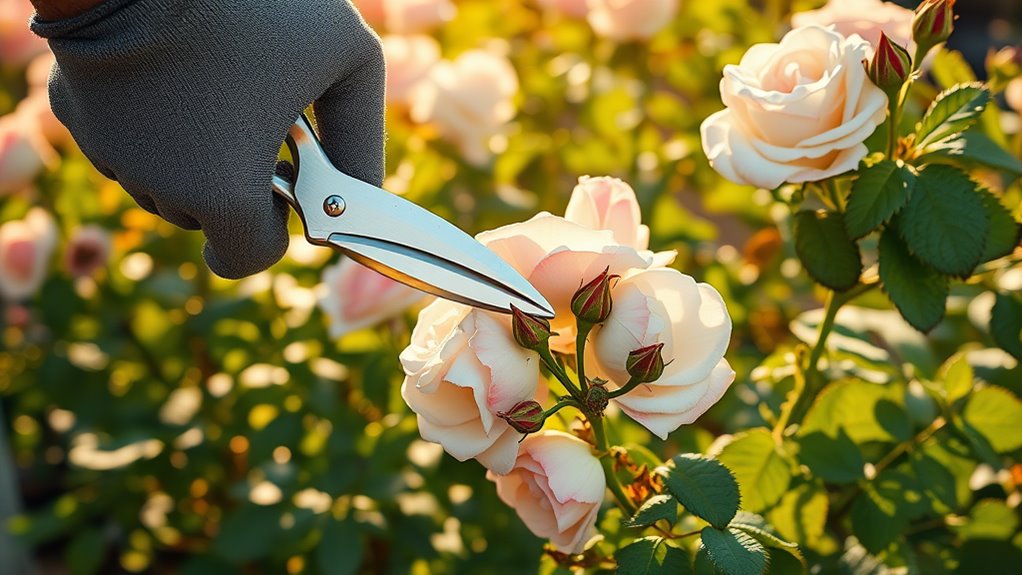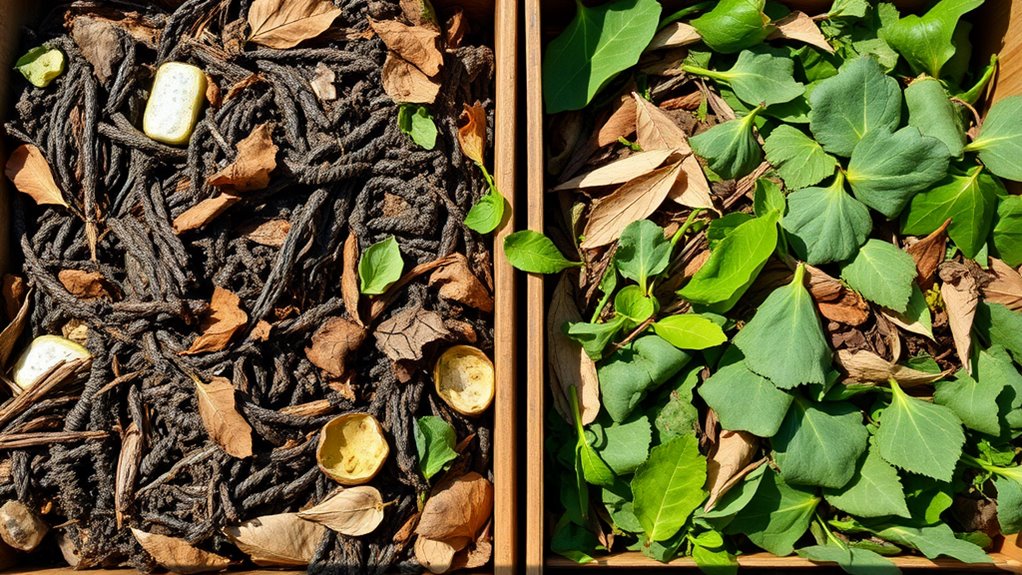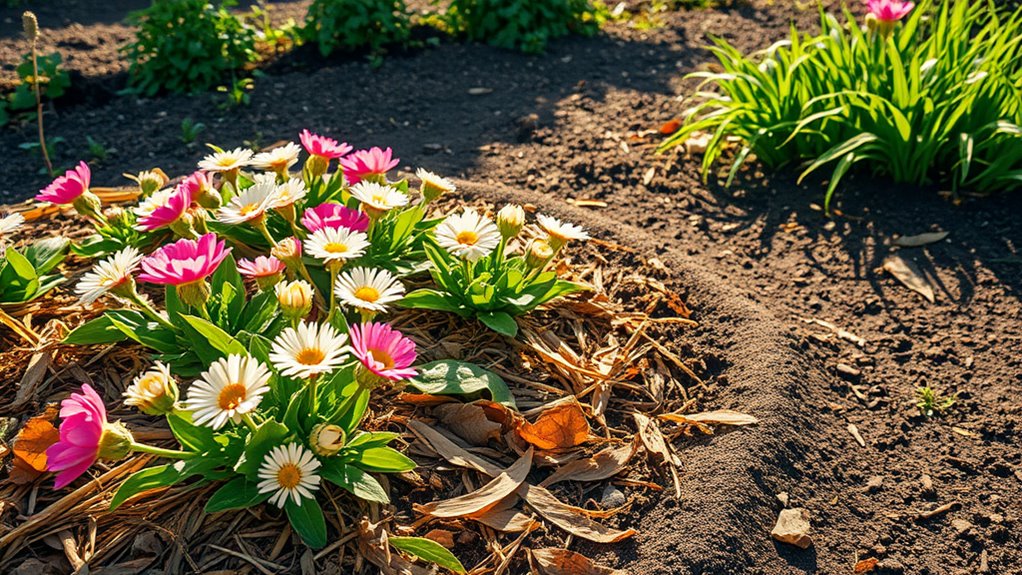How I Use Banana Peels to Keep My Plants Thriving
You’ll boost your plants’ health by turning banana peels into a natural fertilizer packed with potassium, phosphorus, and calcium. First, rinse and chop them into small pieces, then bury around roots for nutrient release or steep in water to make a nutrient-rich tea—dilute it before use. This promotes stronger growth, deeper green leaves, and better pest resistance, especially for roses and tomatoes. As you see these improvements, explore even more effective techniques ahead.
Key Takeaways
- Rinse and chop banana peels into small pieces to prepare them for nutrient release in soil.
- Bury chopped peels around plant bases to deliver potassium, phosphorus, and calcium for healthier growth.
- Steep peels in water to make a nutrient-rich tea, then dilute and use as liquid fertilizer.
- Apply peels in spring as mulch to retain moisture and suppress weeds around seedlings.
- Monitor plants for signs of improvement, like greener leaves and faster growth, after application.
The Nutritional Value of Banana Peels
Banana peels are a nutrient-rich resource for your plants, containing high levels of potassium, phosphorus, and calcium.
As a banana peel fertilizer, you’re harnessing these elements to foster robust growth.
Potassium regulates water uptake and enzyme functions, boosting fruit production and stress tolerance.
Phosphorus drives energy transfer and root expansion, essential for blooming.
Calcium fortifies cell structures, reducing disease vulnerability.
Scientifically, this natural fertilizer enriches soil pH and microbial activity, making it a practical, eco-friendly choice for you to enhance plant vitality and yield without harsh additives. Integrating banana peels into your compost enables a simple ingredient swap for more efficient decomposition.
To maximize these benefits, follow step-by-step instructions for effectively incorporating banana peels into your plant care routine.
Preparing Banana Peels for Your Plants
Once you’ve tapped into the nutritional benefits of these peels, you’ll want to prepare them effectively for your plants.
Start by rinsing peels under cool water to remove dirt and residues, preventing potential fungal issues.
Chop them into small pieces—about one-inch segments—to accelerate decomposition and nutrient release.
For storage, dry peels in a well-ventilated area or oven at low heat (around 200°F) to preserve potassium and other minerals.
Always use fresh or properly dried peels directly in soil, ensuring even distribution around plant bases for optimal uptake.
This method maximizes efficacy while minimizing waste. Combining this with a simple composting technique can further transform your kitchen scraps into valuable garden resources.
Incorporating banana peels into your organic composting practices can help recycle kitchen scraps and enhance soil health.
Making Homemade Banana Peel Tea
If you’ve prepared your banana peels, brewing them into tea offers a simple way to deliver nutrients to your plants. This process draws from an organic fertilizer recipe to enhance plant growth using accessible ingredients.
Chop the peels into small pieces to maximize surface area for extraction. Place them in a container with water—one peel per liter—and bring to a boil.
Let the mixture steep for 24-48 hours, allowing potassium, phosphorus, and calcium to infuse the water. Strain the liquid carefully to remove solids, then dilute it with fresh water at a 1:5 ratio.
This method provides a controlled, nutrient-rich solution that supports plant health without overwhelming roots.
This homemade alternative promotes sustainable practices in gardening by utilizing kitchen waste effectively.
Direct Application Methods for Banana Peels
You’ll find direct application methods for banana peels simple and effective for boosting your plant’s nutrients.
Bury peels directly in the soil around roots to slowly release potassium and other minerals.
You can also use them for mulching garden beds or soaking to create a ready fertilizer solution. This approach can boost plant health by providing essential nutrients naturally.
By using banana peels, you’re embracing organic tips that promote sustainable gardening.
Burying Peels Directly
One effective way to utilize banana peels is burying them directly in your garden soil. This method releases nutrients like potassium and phosphorus as the peels decompose, boosting your plants’ growth naturally.
You’ll enhance soil fertility without synthetic fertilizers, promoting healthier roots and vibrant foliage.
-
Choose ripe peels: Select fresh, clean banana peels to avoid pests and ensure quick breakdown.
-
Dig small holes: Bury peels 1-2 inches deep near plant bases, spacing them 6-12 inches apart for even nutrient distribution.
-
Water thoroughly: After burying, water the area to accelerate decomposition and integrate nutrients into the soil.
-
Monitor progress: Check plants weekly; you’ll notice improved vigor and greener leaves within weeks.
Mulching Garden Beds
Banana peels make an effective mulch for your garden beds, offering a direct way to enrich soil while suppressing weeds and retaining moisture.
You’ll want to chop them into small pieces to accelerate decomposition, allowing nutrients like potassium to integrate quickly into the soil.
Spread a layer around your plants, about two to four inches thick, to create a natural barrier that minimizes evaporation and inhibits weed growth.
This method enhances microbial activity, boosts soil fertility, and promotes healthier root systems without synthetic additives.
Soaking for Fertilizer
Soaking banana peels in water creates a simple liquid fertilizer that delivers essential nutrients like potassium directly to your plants. This method extracts valuable minerals through fermentation, promoting healthier roots and foliage while reducing waste.
It’s an eco-friendly way to boost soil fertility without synthetic chemicals.
-
Gather and steep: Chop peels and soak them in a jar of water for 5-7 days to release potassium and other nutrients.
-
Strain and dilute: Filter the mixture, then dilute it with water (1:5 ratio) to prevent root burn.
-
Apply regularly: Use the liquid to water your plants every 1-2 weeks, watching for vibrant growth.
-
Monitor effects: Track improvements in leaf color and yield, adjusting based on your plants’ responses.
Ideal Plants for Banana Peel Fertilization
Several plants thrive with banana peel fertilization, thanks to its potassium-rich composition that boosts growth and fruit production.
You’ll see roses flourish as potassium strengthens their stems and enhances blooming, making them more vibrant.
For tomatoes, it improves fruit quality and yield by aiding water regulation and enzyme activity.
Peppers benefit similarly, with increased resistance to stress and better pod development.
You can also use it on bananas to promote larger bunches, as it mimics their natural nutrient needs.
Experiment with these in your garden for practical, science-backed results, ensuring balanced application for optimal health.
Incorporating banana peels is part of backyard solutions that utilize everyday materials for soil enhancement.
By using banana peels, you’re engaging in natural soil preparation that enhances your harvest without relying on synthetic fertilizers.
Seasonal Tips for Using Banana Peels
As you incorporate banana peels into your gardening routine, you’ll adapt their use based on the season, beginning with spring tips that enhance early growth through their potassium boost.
In spring, you’re applying peels around emerging plants to support rapid root development and flowering. Additionally, this practice contributes to improved soil health by fostering a nutrient-rich environment that supports overall plant vitality.
For winter, you’ll bury peels deeper to protect soil nutrients from cold snaps and ensure they’re available when plants awaken.
Using banana peels as mulch can also help maintain consistently moist soil, promoting a thriving garden environment.
Spring Peel Tips
As spring blooms with new growth, you’ll discover that banana peels provide a nutrient-rich boost for your plants, thanks to their high potassium content, which supports stronger roots and vibrant foliage.
In spring’s warmer weather, these peels enhance soil fertility and plant resilience.
-
Finely chop peels and bury them near seedlings to deliver potassium quickly, fostering robust root systems in emerging plants.
-
Use shredded peels as mulch to retain soil moisture and suppress weeds, promoting healthier growth during spring rains.
-
Brew a peel infusion by soaking in water for days, then apply as a liquid fertilizer to boost nutrient absorption in budding foliage.
-
Mix peels into compost piles for a balanced nutrient release, ensuring sustained plant vigor as temperatures rise.
Winter Banana Uses
Winter brings cooler temperatures and slower growth, yet you can still tap into banana peels’ potassium to fortify your plants against frost.
Chop peels into small pieces and bury them around plant bases to release nutrients slowly, boosting root resilience and water uptake. This practice minimizes frost damage by strengthening cell walls, as potassium regulates osmosis and enzyme activation.
You’ll enhance soil fertility without synthetic fertilizers; just apply every few weeks and cover with mulch for protection.
Test soil moisture regularly to avoid overwatering, ensuring your plants thrive through the cold season.
Storing Banana Peels Effectively
To store banana peels effectively for use in your plants, you’ll want to choose a method that minimizes moisture and bacterial growth, as these can lead to quick spoilage.
Opt for techniques that preserve nutrients like potassium while preventing mold, ensuring peels remain viable for weeks.
-
Freeze them properly: Chop peels into small pieces, place in a freezer-safe bag, and seal tightly to stop bacterial activity and lock in minerals.
-
Dry thoroughly: Use a dehydrator or low-heat oven to remove moisture, creating crisp peels that store longer without spoiling.
-
Refrigerate wisely: Wrap peels in paper towels inside an airtight container to absorb excess water and slow decay.
-
Ferment if needed: Submerge in a jar with water and a bit of salt to create a nutrient-rich liquid, reducing spoilage risks scientifically.
Signs of Improved Plant Health
Once you’ve stored your banana peels correctly, you’ll spot key indicators of enhanced plant health, such as deeper green foliage and faster growth, which show that nutrients like potassium are fueling stronger roots and overall vitality.
You’ll also notice increased resistance to common pests, as potassium bolsters cell walls, making plants more robust.
Scientifically, this manifests in thicker stems and vibrant blooms, signaling better nutrient uptake.
Track these changes weekly; for instance, measure growth rates to quantify improvements, ensuring your plants thrive efficiently with minimal effort.
Combining Banana Peels With Compost
While banana peels offer a quick nutrient boost, combining them with compost amplifies their impact by fostering a balanced microbial environment.
You’ll enhance nutrient release and soil structure, making your plants more resilient. This method breaks down peels faster, delivering potassium, phosphorus, and calcium effectively.
-
Chop and mix: Finely chop peels and blend them into your compost pile to speed up decomposition and integrate nutrients evenly.
-
Balance moisture: Keep your compost moist but not soggy, allowing beneficial microbes to thrive and process the peels efficiently.
-
Layer strategically: Add peels in layers with other organic matter, creating a diverse ecosystem that supports root health.
-
Monitor pH levels: Test your compost’s pH periodically to ensure it’s optimal, as banana peels can slightly acidify it, aiding nutrient uptake.
Troubleshooting Common Issues
Even though banana peels enrich soil effectively, you might encounter problems like slow decomposition or pest attraction; here’s how to identify and resolve them quickly.
To identify slow decomposition, check if peels remain intact after two weeks—it’s often due to low moisture or poor aeration. Add water, turn your compost pile, and chop peels into smaller pieces to boost microbial activity and speed breakdown.
For pest attraction, watch for insects like fruit flies drawn to sugars; bury peels at least six inches deep and apply natural repellents like neem oil.
Regularly test soil pH to prevent acidification, ensuring balanced nutrient release for healthier plants.





